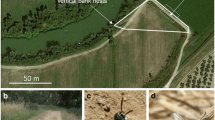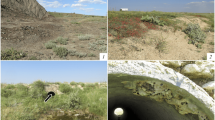Abstract
Nest-site selection by the solitary ground-nesting wasp Ammophila dysmicaMenke was studied during 1982–1986 in California's Sierra Nevada Mountains. Digging females detected and discriminated among members of a complex of insect intruders, including a number of predators and parasites. In response to some natural enemies, wasps sometimes permanently abandoned nests under construction. These selective nest abandonments reduced the mean number of cleptoparasitic chrysidid wasps, Argochrysis armillaBohart, attending the excavation of completed nests. The number of A. armillaattending a nest excavation correlated positively with the probability of nest parasitism by this species. Selective nest abandonment may reduce parasitism rates.
Similar content being viewed by others
References
Brockmann, H. J. (1979). Nest-site selection in the great golden digger wasp,Sphex ichneumoneus L. (Sphecidae).Ecol. Entomol. 4: 211–224.
Brockmann, H. J., and Dawkins, R. (1979). Joint nesting in a digger wasp as an evolutionarily stable preadaptation to social life.Behaviour 71: 203–245.
Cooper, S. D. (1984). The effects of trout on water striders in stream pools.Oecologia 63: 376–379.
Endo, A. (1980). On the host-cleptoparasite relationship between the spider waspEpisyron arrogans (Smith) (Hymenoptera, Pompilidae) and the miltogrammine flyMetopia sauteri (Townsend) (Diptera, Sarcophagidae).Jap. J. Ecol. 30: 117–132.
Evans, H. E., O'Neill, K. M., and O'Neill, R. P. (1986). Nesting site changes and nocturnal clustering in the sand waspBembecinus quinquespinosus (Hymenoptera: Sphecidae).J. Kans. Entomol. Soc. 59: 280–286.
Freeman, B. E. (1982). The comparative distribution and population dynamics in Trinidad of Sceliphron fistularium (Dahlbom) andS. asiaticum (L.) (Hymenoptera: Sphecidae).Biol. J. Linn. Soc. 17: 343–360.
Freeman, B. E., and Jayasingh, D. B. (1975). Population dynamics ofPachodynerus nasidens (Hymenoptera) in Jamaica.Oikos 26: 86–91.
Freeman, B. E., and Parnell, J. R. (1973). Mortality ofSceliphron assimile Dahlbom (Sphecidae) caused by the eulophidMelittobia chalybii Ashmead.J. Anim. Ecol. 42: 779–784.
Freeman, B. E., and Taffe, C. A. (1974). Population dynamics and nesting behaviour ofEumenes colona (Hymenoptera) in Jamaica.Oikos 25: 388–394.
Jaenike, J. (1985). Parasite pressure and the evolution of amanitin tolerance inDrosophila.Evolution 39: 1295–1301.
Kettlewell, B. (1973).The evolution of melanism, Clarendon Press, Oxford.
Larsson, R. K. (1985). Individual size and nesting patterns in the gregarious digger waspBembix rostrata L. (Hymenoptera: Sphecidae).Entomol. Tidskr. 106: 1–6.
Miller, J. R., and Strickler, K. L. (1984). Finding and accepting host plants. In Bell, W. J., and Cardé, R. T. (eds.),Chemical Ecology of Insects, Sinauer Associates, Sunderland, Mass., pp. 127–157.
Peckham, D. J. (1977). Reduction of miltogrammine cleptoparasitism by maleOxybelus subulatus (Hymenoptera: Sphecidae).Ann. Entomol. Soc. Am. 70: 823–828.
Prokopy, R. J., and Owens, E. D. (1983). Visual detection of plants by herbivorous insects.Annu. Rev. Entomol. 28: 337–364.
Rosenheim, J. A. (1987a). Nesting behavior and bionomics of a solitary ground-nesting wasp,Ammophila dysmica (Hymenoptera: Sphecidae): The influence of parasite pressure.Ann. Entomol. Soc. Am. 80: 739–749.
Rosenheim, J. A. (1987b). Host location and exploitation by the cleptoparasitic waspArgochrysis armilla: The role of learning (Hymenoptera: Chrysididae).Behav. Ecol. Sociobiol. 21: 401–406.
Rosenheim, J. A., and Grace, J. K. (1987). Biology of a wood-nesting wasp,Mimumesa mixta (Hymenoptera: Sphecidae) and its parasite,Elampus viridicyaneus (Hymenoptera: Chrysididae).Proc. Entomol. Soc. Wash. 89: 351–355.
Rubink, W. L. (1979).The Use of Edaphic Factors as Cues for Nest-Site Selection by Sand Wasps, Ph.D. dissertation, Colorado State University, Fort Collins.
Rubink, W. L. (1982). Spatial patterns in a nesting aggregation of solitary wasps: Evidence for the role of conspecifics in nest-site selection.J. Kans. Entomol. Soc. 55: 52–56.
Sih, A. (1986). Antipredator responses and the perception of danger by mosquito larvae.Ecology 67:434–441.
Spofford, M. G., Kurczewski, F. E., and Peckham, D. J. (1986). Cleptoparasitism ofTachysphex terminatus (Hymenoptera: Sphecidae) by three species of Miltogrammini (Diptera: Sarcophagidae).Ann. Entomol. Soc. Am. 79: 350–358.
Taffe, C. A., and Ittyeipe, K. (1976). Effect of nest substrata on the mortality ofEumenes colona Saussure (Hymenoptera) and its inquilines.J. Anim. Ecol. 45: 303–311.
Toft, C. A. (1987). Activity budgets, habitat use and body size in two coexisting species of sand wasps (Microbembex: Sphecidae, Hymenoptera).Ecol. Entomol. 12: 427–438.
Vinson, S. B. (1984). Parasitoid-host relationship.In Bell, W. J., and Cardé, R. T. (eds.),Chemical Ecology of Insects, Sinauer Associates, Sunderland, Mass., pp. 205–233.
Wcislo, W. T. (1984). Gregarious nesting of a digger wasp as a “selfish herd” response to a parasitic fly (Hymenoptera: Sphecidae; Diptera: Sarcophagidae).Behav. Ecol. Sociobiol. 15: 157–160.
Author information
Authors and Affiliations
Rights and permissions
About this article
Cite this article
Rosenheim, J.A. Parasite presence acts as a proximate cue in the nest-site selection process of the solitary digger wasp,Ammophila dysmica (Hymenoptera: Sphecidae). J Insect Behav 1, 333–342 (1988). https://doi.org/10.1007/BF01054496
Accepted:
Issue Date:
DOI: https://doi.org/10.1007/BF01054496




